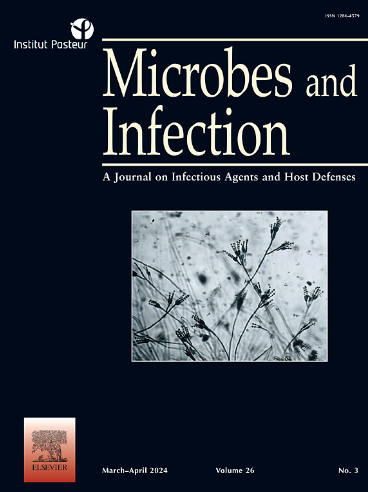Bordetella pertussis outer membrane vesicles impair neutrophil bactericidal activity
IF 2.6
4区 医学
Q3 IMMUNOLOGY
引用次数: 0
Abstract
Neutrophils constitute the primary defense against bacterial infections, yet certain pathogens express virulence factors that enable them to subvert neutrophils-mediated killing. Outer membrane vesicles (OMVs) have emerged as a secretory system through which bacteria deliver virulence factors to host cells. OMVs from Bordetella pertussis, the etiological agent of whooping cough, are loaded with most of bacterial virulence factors, including CyaA, which plays a key role in B. pertussis evasion of neutrophils bactericidal activity. In our study, we investigated the role of B. pertussis OMVs in bacterial interaction with neutrophils. We observed that interaction of OMVs with neutrophils led to a decrease in the expression of cell surface CR3 and FcγRs, an effect dependent on the CyaA toxin delivered by these vesicles. This decreased receptor expression led to reduced bacterial uptake by neutrophils, irrespective of the presence of opsonic antibodies. Moreover, CyaA delivered by OMVs hindered intracellular bactericidal trafficking, promoting bacterial intracellular survival. When both bacteria and OMVs were opsonized, competition between opsonized OMVs and B. pertussis for FcγRs on neutrophils led to a significant decrease in bacterial uptake. Overall, our findings suggest that B. pertussis OMVs promote bacterial survival to the encounter with neutrophils in both naïve and immunized individuals.
百日咳杆菌外膜囊泡损害中性粒细胞的杀菌活性。
中性粒细胞是抵御细菌感染的主要防御系统,然而某些病原体表达的毒力因子却能使它们抵御中性粒细胞介导的杀灭作用。外膜囊泡 (OMV) 已成为细菌向宿主细胞传递毒力因子的一种分泌系统。百日咳病原体百日咳杆菌的外膜囊泡富含大多数细菌毒力因子,其中包括在百日咳杆菌逃避中性粒细胞杀菌活动中发挥关键作用的 CyaA。在我们的研究中,我们调查了百日咳杆菌 OMVs 在细菌与中性粒细胞相互作用中的作用。我们观察到,OMVs 与中性粒细胞的相互作用导致细胞表面 CR3 和 FcγRs 的表达减少,这种效应依赖于这些囊泡传递的 CyaA 毒素。这种受体表达的降低导致中性粒细胞对细菌的摄取减少,而与蛋白抗体的存在无关。此外,OMVs 释放的 CyaA 会阻碍细胞内的杀菌运输,促进细菌在细胞内存活。当细菌和 OMV 都被蛋白化时,蛋白化的 OMV 与百日咳杆菌竞争中性粒细胞上的 FcγRs 会导致细菌摄取量显著下降。总之,我们的研究结果表明,百日咳杆菌 OMV 可促进细菌在与中性粒细胞相遇时的存活,无论是在未接种疫苗的个体中还是在已接种疫苗的个体中。
本文章由计算机程序翻译,如有差异,请以英文原文为准。
求助全文
约1分钟内获得全文
求助全文
来源期刊

Microbes and Infection
医学-病毒学
CiteScore
12.60
自引率
1.70%
发文量
90
审稿时长
40 days
期刊介绍:
Microbes and Infection publishes 10 peer-reviewed issues per year in all fields of infection and immunity, covering the different levels of host-microbe interactions, and in particular:
the molecular biology and cell biology of the crosstalk between hosts (human and model organisms) and microbes (viruses, bacteria, parasites and fungi), including molecular virulence and evasion mechanisms.
the immune response to infection, including pathogenesis and host susceptibility.
emerging human infectious diseases.
systems immunology.
molecular epidemiology/genetics of host pathogen interactions.
microbiota and host "interactions".
vaccine development, including novel strategies and adjuvants.
Clinical studies, accounts of clinical trials and biomarker studies in infectious diseases are within the scope of the journal.
Microbes and Infection publishes articles on human pathogens or pathogens of model systems. However, articles on other microbes can be published if they contribute to our understanding of basic mechanisms of host-pathogen interactions. Purely descriptive and preliminary studies are discouraged.
 求助内容:
求助内容: 应助结果提醒方式:
应助结果提醒方式:


